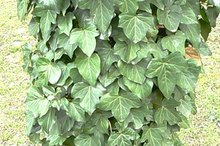Consequences of a Prolonged Poison Ivy Rash
Triggered by an allergic reaction to the plant oil called urushiol, poison ivy rashes produce a severe prolonged itching that will not stop. Poison Oak Rash.net states that about 80 percent of the general population will be allergic to urushiol 2. Poison sumac and poison oak plants produce the same oil, which causes the poison ivy rash 2. According to the MayoClinic.com, the rash is bothersome, but not serious 1. However, the consequences of a prolonged poison ivy rash can be complicated.
Widespread Rashes
The MayoClinic.com encourages patients with widespread contact dermatitis caused by poison ivy to see their doctor 1. If the rash is severe due to a heavy inoculation of urushiol, a doctor can prescribe steroid treatment to alleviate the symptoms of the rash.
Dermatitis
Home Remedies for Poison Sumac
Learn More
Dermatitis, or infection of the skin, complicates a rash caused by urushiol. The severe itching and scratching exposes the skin to germs on the hands. Some of these bacteria cause severe infections with Staphylococcus aureus, commonly called staph, and methcyllin resistant Staphylococcus aureus, commonly called MRSA 3. According to KidsHealth, an information website sponsored by the Nemours Foundation, staph bacteria can enter broken skin and cause infections, which can lead to other health problems 3.
- Dermatitis, or infection of the skin, complicates a rash caused by urushiol.
- Some of these bacteria cause severe infections with Staphylococcus aureus, commonly called staph, and methcyllin resistant Staphylococcus aureus, commonly called MRSA 3.
Systemic Involvement
If the eyes, mouth or genitals are involved, or a fever of greater than 100 degrees occurs, systemic involvement is present. The rash will not get better by itself and a dermatologist’s treatment is necessary 2.
Prolonged Rashes
Can I Get Relief from Poison Ivy in a Swimming Pool?
Learn More
Contact dermatitis caused by urushiol does not “spread” on its own. Reinfections occur because contact is made repeatedly with the oil present on clothes, pets, furniture or the plant itself. Wash all clothing in cool soapy water to remove the oil. Bathe pets in cool soapy water and rinse thoroughly. Use a clean, damp towel to wipe furniture and wash it with any contaminated clothing. Learn to recognize the poison oak, ivy and sumac plants and avoid them. If you must come in contact with areas of plant growth, cover the skin completely, wear gloves and avoid touching any unprotected skin. Remove protective clothing as soon as possible, wash separately in cool soapy water and segregate the clothes from any other clothing.
- Contact dermatitis caused by urushiol does not “spread” on its own.
- Remove protective clothing as soon as possible, wash separately in cool soapy water and segregate the clothes from any other clothing.
Related Articles
References
- MayoClinic.com: Poison Ivy Rash: Symptoms
- KidsHealth: Staph Infections
- Prok L, McGovern T. Patient education: Poison ivy (Beyond the Basics). UpToDate. Updated March 25, 2019.
- American Academy of Dermatology. (2018). Poison ivy, oak, and sumac. https://www.aad.org/public/diseases/itchy-skin/poison-ivy-oak-and-sumac
- U.S. Food and Drug Administration. (2016). Outsmarting Poison Ivy and Its Cousins. https://www.fda.gov/ForConsumers/ConsumerUpdates/ucm049342.htm
- Boston Children's Hospital. Poison Ivy, Poison Oak and Poison Sumac.
- American Academy of Dermatology. Poison Ivy, Oak, and Sumac: Who gets a rash and is it contagious?
- Prok L, McGovern T. Patient education: Poison ivy (Beyond the Basics). Updated March 25, 2019.
- U.S. Food and Drug Administration. Outsmarting Poison Ivy and Other Poisonous Plants. Updated August 6, 2016.
- Porter R. Poison Ivy, Poison Oak and Poison Sumac. National Capital Poison Center.
- Usatine RP, Riojas M. Diagnosis and management of contact dermatitis. Am Fam Physician. 2010;82(3):249-55.
- MedlinePlus. Bentoquatam Topical. Updated February 15, 2018.
- American Academy of Dermatology. (2018). Poison ivy, oak, and sumac.
- Curtis G, Lewis AC. Treatment of severe poison ivy: a randomized, controlled trial of long versus short course oral prednisone. J Clin Med Res. 2014 Dec;6(6):429-34. doi: 10.14740/jocmr1855w.
- Habif TP. Clinical Dermatology: A Color Guide to Diagnosis and Therapy. Elsevier; 2016.
- U.S. Food and Drug Administration. (2016). Outsmarting Poison Ivy and Its Cousins.
Writer Bio
Lela A. Cargill, M.T. (ASCP), B.A., is a certified medical laboratory scientist with more than 30 years of experience. Her specialty is transfusion medicine. Her degree at Sam Houston State University includes emphasis in journalism and photography. She writes for Examiner.com, HubPages, and eHow. Also known as Austinstar, she writes articles on art, travel and the health sciences.








